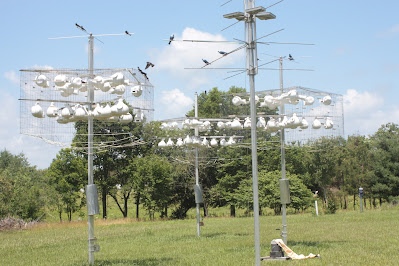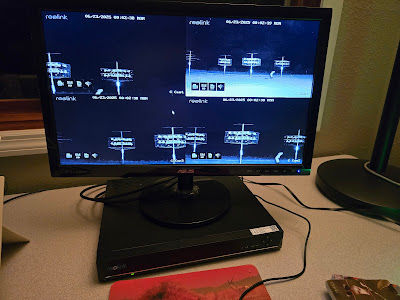We are in the stage right now where there are tons of feeding trips occurring in my colony. With only 5 nests fledged, the vast majority of my nests have young, ranging from 1-day old up to 20 days old. That's a LOT of food requirements. Take THAT bugs!! It's amazing to watch how fast the adults deliver food, then depart on another hunting trip. I can always tell when there's another nest preparing to fledge because the fledgling escort crews show up and the normally-very-quiet colony (during this stage), starts becoming very vocal. So, I go watch.
 |
| The small escort crew (because the other adults are working - feeding their young!) |
It always fascinates me and I ask - HOW do they (the escort crews) KNOW there are young martins about to fledge? Does a martin-wide memo go out in the Purple Martin Kingdom to notify them all of the date & time they need to show up? I need more information, please (and send me a copy of that memo!).
 |
| Today's escort crew is small, compared to others. Probably because the vast majority of my colony are parents engaged in feeding their young. |
I recently received a lot of questions regarding how I monitor my colony. Which system? Does it record all night? Does it use WiFi - or do you have to connect via an Ethernet cable?
After using the Browning Trail cameras for years to monitor my colony, I was getting tired of having to change out batteries, retrieve & replace the cards every day, but the most daunting realization - I realized I was probably missing some of the owl's activities because the limitations that are always a 'feature' of game cameras. If the owl's attack was too fast, if she was out of range or even didn't cross the required pixels to trigger the camera, or the camera didn't trigger fast enough, I wouldn't know about her attacks. It was time to improve my game. I had already spent a lot of time, effort & money on my systems and the caging, so, why not verify it's working?
I realized Bob and I had set this up about 5 years ago and while I knew all the answers about it then, I had forgotten the very, very deep details about this system. Details that are critical to choosing a system for this particular application. So, I'm documenting them here, and sharing them with you, in case you ever need them. The best part? NO MORE batteries, NO MORE cards, and NO MORE missed activities!
We decided on 4 Reolink RLC-511W cameras (look for the cameras & package deals like this one to be on sale!). The most important qualities for me:
- Zoom - Optical Zoom (digital zoom is too pixelated)! (my cameras are 75' from my colony). I've dedicated one camera to each rack - zoom & focus the racks (3 racks) and the 4th camera to monitor the overall yard (not zoomed in).
- Night vision (they have an IR range of 100'). We added the IR illuminator, which extends the range of the IR out to 300', just to ensure complete coverage. Because "100 feet" really means, "only about 50 effective feet". That's true with all the "night-vision" cameras I've ever tried.
- Most importantly - continuous recording, all night long. Living out in the country, I found motion detection just isn't something I should use. Rain and every large bug that runs / flies across the screen triggers the recordings and I would sometimes miss the owl.
- WiFi - we didn't want to run yet another wire to connect it to the router.
 | ||
| My 4 Reolink RLC-511W cameras + the IR illuminator. Bob built these shelves for me, making the whole system easy to remove for winter storage. |
 |
| The NVR system combined with a cheap monitor! |
 |
| Outdoor power supply with weather proof cover. |
By removing the 4 screws that are used to mount these boards to the porch posts, I can quickly disconnect the wires and bring the cameras inside for winter storage in our unfinished basement.
 |
| The cameras stored in our basement. Keeping them out of the winter weather extremes will help extend the life of the cameras. |
I created this video in the process of documenting our setup.
Yes, it's an outlay of cash. Is it worth it? I emphatically say, "YES!" It has been the last piece of the puzzle that I needed to give me insight to what was happening with my colony every night and give me the information I needed, in case I needed to quickly adapt in order to thwart her ability to catch martins.
This is a video from the camera that I use to monitor the entire yard:
I am so happy to see that the owl's attacks have been lessening every year. I'm not going to mention a number because I don't want to jinx myself (or my colony). But knowing what's happening in my yard every night is helping me to sleep more peacefully. And, I've repurposed the Browning cameras to watch the activities on my trails so I can see if Molly is still hanging around! Win, WIN!






